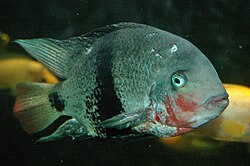Taxonomy and species
Historically, Vieja was included in Cichlasoma . Once recognized as its own genus, it sometimes included most of the superficially similar, relatively large and high-bodied cichlids of Central America and southern Mexico, but several of these are now considered to belong to separate genera: Chuco , Cincelichthys , Isthmoheros , Kihnichthys , Maskaheros and Oscura (Oscuro might still be better merged with Vieja, but this remains unconfirmed). Conversely, Vieja has sometimes been included in Paraneetroplus . [1] [3]
There are currently 8 recognized species in the genus Vieja: [2]
In addition to these, two further species have commonly been recognized: The first is V. coatlicue, but today it is usually considered the Atlantic slope population of V. zonata. [4] The second is V. synspilum, in which case V. melanurus is limited to the Lake Petén system, but a review found that the supposed differences between them are invalid. [5]
Because of individual, regional and age-related variations, definite separation of some species can be difficult. [6] Furthermore, hybrids occur, sometimes even between a Vieja species and a species from another heroine genus. [7] The enigmatic Amphilophus margaritifer, sometimes still recognized as a valid species, is most likely a hybrid involving Thorichthys and Vieja. [3] [8]
This page is based on this
Wikipedia article Text is available under the
CC BY-SA 4.0 license; additional terms may apply.
Images, videos and audio are available under their respective licenses.

